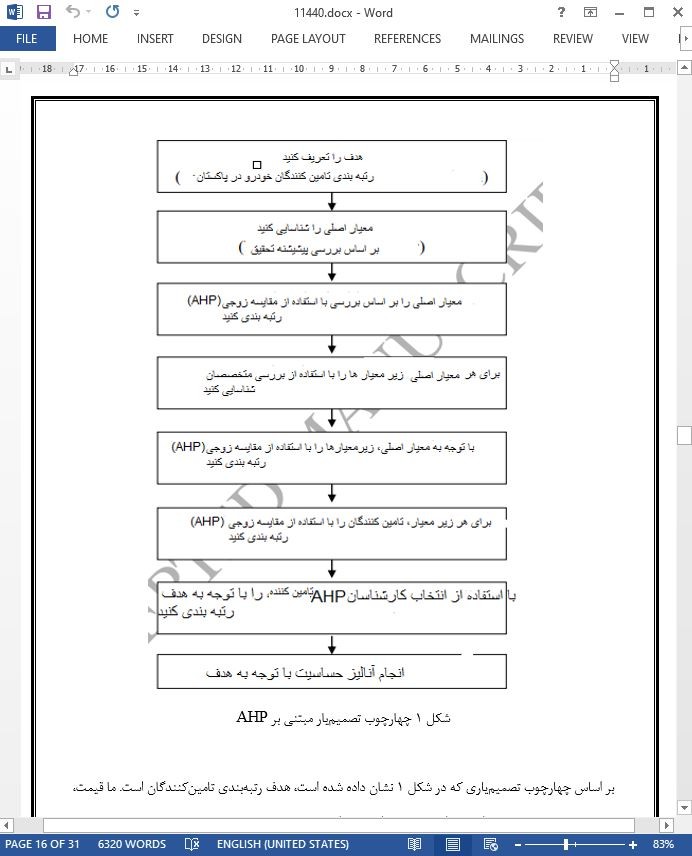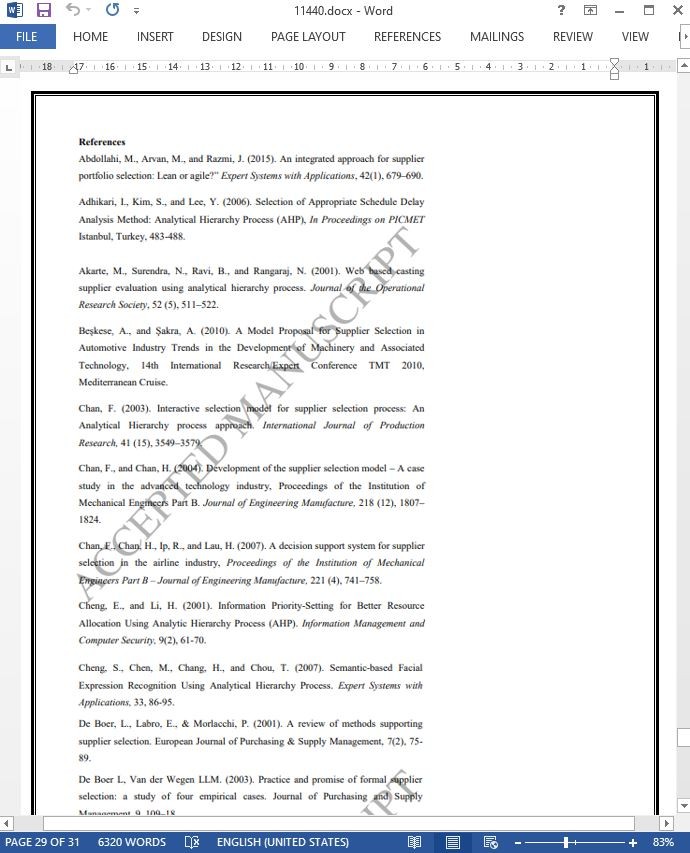
طراحی یک سیستم تصمیم یار مبتنی بر فرآیند تحلیل سلسله مراتبی یکپارچه
چکیده
هدف: هدف از این مقاله ارائه یک مدل تصمیمیار برای انتخاب تامینکننده بر اساس فرآیند تحلیل سلسلهمراتبی (AHP) با استفاده از مورد صنعت خودروسازی در یک کشور در حال توسعه مثل پاکستان است و در ادامه کار آنالیز حساسیت به منظور بررسی استواری تصمیمگیری انتخاب تامینکننده صورت میگیرد.
متدولوژی : مدل با شناسایی معیارهای اصلی (قیمت، کیفیت، تحویل و خدمات) با استفاده از بررسی پیشینه تحقیق و رتبهبندی معیارهای اصلی بر اساس نظرات کارشناسان با استفاده از AHP آغاز میشود. مرحله دوم در متدولوژی اتخاذی، شناسایی زیرمعیارها و رتبهبندی آنها بر اساس معیارهای اصلی است. در نهایت آنالیز حساسیت برای بررسی استواری تصمیم با استفاده از نرمافزار Expert Choice صورت میپذیرد.
یافتهها: تامینکنندگان بر اساس زیرمعیارها انتخاب و رتبهبندی شدهاند. آنالیز حساسیت اثرات تغییرات معیارهای اصلی را بر روی رتبهبندی تامینکنندگان نمایش میدهد. استفاده از AHP در انتخاب تامینکننده به تصمیم گیرنده اطمینان از انسجام و استواری در سراسر فرآیند را میدهد.
کاربردهای عملی: متدولوژی AHP که در این تحقیق اتخاذ شده است، مدیران صنعت خودروسازی پاکستان را با بینشهایی در مورد عوامل مختلفی که باید در هنگام انتخاب تامینکنندگان برای سازمان آنها را در نظر بگیرند، یاری میکند. رویکرد انتخاب شده همچنین به آنها در تعیین اولویتبندی معیار کمک میکند. مدیران میتوانند از ساختار سلسله مراتبی متدولوژی انتخاب تامینکننده پیشنهادی در این مقاله به منظور رتبهبندی تامینکنندگان بر اساس عوامل یا معیارهای مختلف استفاده کنند.
اصالت / ارزش: این مطالعه به سه بخش جدید در زمینه انتخاب تامینکننده کمک میکند. اول، AHP برای صنعت خودرو استفاده میشود و استفاده از AHP در انتخاب تامینکننده به تصمیمگیرنده اطمینان از انسجام را میدهد. دوم، آنالیز حساسیت سبب توانبخشی در درک اثرات تغییرات در معیار اصلی در رتبهبندی تامینکنندگان میشود و به تصمیمگیرندگان به منظور بررسی استواری در طی فرآیند نیز کمک میکند. در نهایت، ما رویکردی ساده را برای مدیران صنعیت خودروسازی را ارائه میدهیم تا آنها قادر به انتخاب بهترین تامینکننده باشند. علاوه بر این، این روش همچنین به مدیران در تقسیم مسئله تصمیمگیری پیچیده به مسئلهای با سلسله مراتبی سادهتر کمک خواهد کرد.
4. نتیجهگیری و کارهای آتی
انتخاب یک تامینکننده مناسب نقشی مهم در عملکرد زنجیره تامین سازمانی دارد تا بتوان به منظور دستیابی به رضایت مشتری، تقاضای مشتری را به موقع و با هزینهای مناسب پاسخ داد. در این مقاله مدلی برای رتبه بندی تامینکنندگان صنعت خودروسازی در پاکستان ارائه شده است. با توجه به پیچیدگی این مسئله، از ابزار تصمیمگیری چند معیاره(AHP) استفاده شده است. این مسئله به دو سلسله مراتب تقسیم شد (معیارهای اصلی و زیرمعیارها) که بر اساس پیشینه تحقیق شناسایی شدند. این معیارها براساس نظرات کارشناسان با استفاده از رویکرد مقایسه زوجی AHP رتبهبندی شدند. نتایج رتبه بندی معیارهای اصلی عبارتند از: قیمت (47٪)، کیفیت (28٪)، تحویل (16٪) و خدمات (10٪) و ناسازگاری 0.01. مجموعهای از زیرمعیارها نیز با توجه به معیارهای اصلی مربوط به خود معیار اصلی با استفاده از همان روند شناسایی و رتبهبندی شدند. سه تامینکننده در این فرآیند انتخاب و رتبهبندی شدند. در نهایت، آنالیز حساسیت به منظور بررسی اثر تغییر وزن معیارهای اصلی در رتبه بندی تامینکنندگان انجام شد. مزایای این رویکرد این است که مسئله پیچیده را به سلسله مراتب سادهتری تقسیم میکند و سبب ناسازگاری پایین بین قضاوت تصمیمگیرندهها میشود. استفاده از آنالیز حساسیت سبب شناسایی محدودهای از تغییرات وزنهای معیار اصلی میشود در حالیکه رتبهبندی تامینکنندگان استوار میماند.
Abstract
Purpose The purpose of this paper is to propose a decision support model for supplier selection based on analytic hierarchy process (AHP) using a case of automotive industry in a developing country of Pakistan and further performs sensitivity analysis to check the robustness of the supplier selection decision.
Methodology The model starts by identifying the main criteria (price, quality, delivery and service) using literature review and ranking the main criteria based on experts’ opinions using AHP. The second stage in the adopted methodology is the identification of sub criteria and ranking them on the basis of main criteria. Lastly perform sensitivity analysis to check the robustness of the decision using Expert Choiceۛ software.
Findings The suppliers are selected and ranked based on sub criteria. Sensitivity analysis suggests the effects of changes in the main criteria on the suppliers ranking. The use of AHP in the supplier selection gives the decision maker the confidence of the consistency and the robustness throughout the process.
Practical implications The AHP methodology adopted in this study provides managers in automotive industry in Pakistan with the insights of the various factors that need to be considered while selecting suppliers for their organizations. The selected approach also aids them in prioritizing the criterion. Managers can utilize the hierarchical structure of adopted supplier selection methodology suggested in this study to rank the suppliers on the basis of various factors/criteria.
Originality/value This study makes three novel contributions in supplier selection area. First, AHP is applied to automotive industry and use of AHP in the supplier selection gives decision maker the confidence of the consistency. Second, sensitivity analysis enables in understanding the effects of changes in the main criteria on the suppliers ranking and help decision maker to check the robustness throughout the process. Last, we find it important to come with a simple methodology for managers of automotive industry so that they can select the best suppliers. Moreover, this approach will also help managers in dividing the complex decision making problem into simpler hierarchy.
4. Conclusion and Future
Research Directions Selecting an appropriate supplier plays a vital role in the supply chain performance of the organization in order to meet customer demand in a timely and cost effective manner in order to achieve their satisfaction. This paper proposed a model for ranking the suppliers for the automotive industry in Pakistan used as an example. Due to the complexity of the problem, we used the multi criteria decision making tool (AHP). The problem is divided into two hierarchies (main criteria and sub criteria). The main criteria (Price, Quality, Delivery and Service) are identified based on literature review. These criterions are ranked based on the experts‟ opinions using AHP pair wise comparison approach. The results of the ranking of the main criteria are Price (47%), Quality (28%), Delivery (16%) and Service (10%) with inconsistency of 0.01. Sets of sub criterion are identified and ranked with respect to their associated main criteria using the same process. Three suppliers are selected and ranked in this process. Finally, sensitivity analysis is performed to study the effect of changing the weights of the main criteria on the ranking of suppliers. The benefits of this approach are that it divides the complex problem into simpler hierarchy as well as low inconsistency of the decision makers‟ judgments. The use of sensitivity analysis identified the range of change of the main criterion weights while the ranking of supplier stay robust.
نکات برجسته
چکیده
1. مقدمه
1. 1 صنعت خودروسازی در پاکستان
1 .2 انتخاب تامینکننده
1. 3 فرآیند تحلیل سلسلهمراتبی
2. بررسی پیشینه تحقیق
2 .1 تعریف مسئله و گسست تحقیقاتی
2 .2 اعانه مقاله
3. متدولوژی
3 .1 آنالیز حساسیت
4. نتیجهگیری و کارهای آتی
Highlights
Abstract
1. Introduction
1.1 Automobile Industry in Pakistan
1.2 Supplier Selection
1.3 Analytical hierarchy process
2. Literature Review
2.1 Problem Definition and Research Gap
2.2 Contribution of the Study
3. Methodology
3.1 Sensitivity Analysis
4. Conclusion and Future Research Directions
- ترجمه فارسی مقاله با فرمت ورد (word) با قابلیت ویرایش، بدون آرم سایت ای ترجمه
- ترجمه فارسی مقاله با فرمت pdf، بدون آرم سایت ای ترجمه



